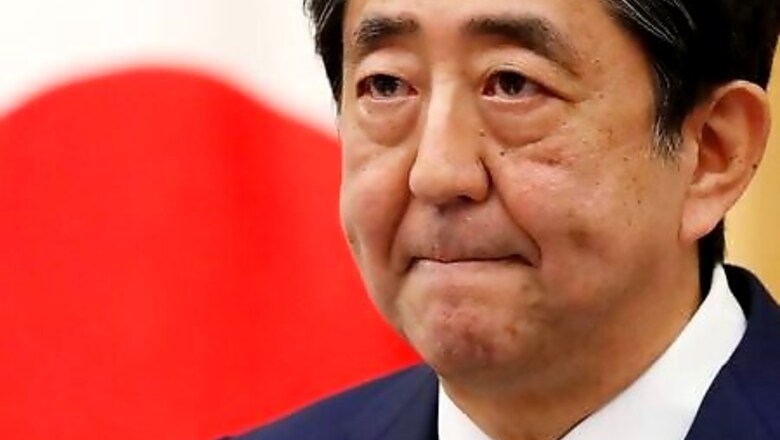
views
,: Japan’s Shinzo Abe swept back for a rare second stint as prime minister in 2012 pledging to revive a stagnant economy, loosen the limits of a post-World War Two pacifist constitution and restore traditional values.
Abe became Japan’s longest-serving premier in November 2019. But by the summer of 2020, public support had been eroded by his handling of the COVID-19 outbreak as well as a series of scandals including the arrest of his former justice minister.
On Friday, a person familiar with the matter said he had decided to resign, news that followed days of speculation about his health. Public broadcaster NHK earlier said Abe wanted to avoid causing problems for the government due to his worsening condition.
Abe first took office in 2006 as Japan’s youngest prime minister since World War Two. After a year plagued by political scandals, voter outrage at lost pension records, and an election drubbing for his ruling party, Abe quit citing ill health.
“What worries me most now is that because of my resigning, the conservative ideals that the Abe administration raised will fade,” Abe subsequently wrote in the magazine Bungei Shunju.
“From now on, I want to sacrifice myself as one lawmaker to make true conservatism take root in Japan.”
Five years after resigning, which he blamed on the intestinal ailment ulcerative colitis, Abe led his conservative Liberal Democratic Party (LDP) – ousted in 2009 – back to power.
He then launched a three-pronged “Abenomics” strategy to beat persistent deflation and revive economic growth with hyper-easy monetary policy and fiscal spending, along with structural reform to cope with a fast-aging, shrinking population.
Deflation proved stubborn, however, and his growth strategy suffered in 2019 from a sales tax hike and Sino-U.S. trade war. The COVID-19 outbreak the following year triggered Japan’s biggest-ever economic slump.
At the outbreak’s onset, Abe was slow to close Japan’s borders and implement a state of emergency urging people to stay home and shops to close. Critics initially branded the response clumsy and later faulted Abe for a lack of leadership.
Still, Japan’s death rate remained far below that of many other developed nations.
DYNASTY
Abe hailed from a wealthy political family that included a foreign minister father and a great-uncle who served as premier. But when it came to many policies, his grandfather, the late prime minister Nobusuke Kishi, seems to have mattered most.
Kishi was a wartime cabinet minister imprisoned but never tried as a war criminal after World War Two. He served as prime minister from 1957 to 1960, resigning due to public furore over a renegotiated U.S.-Japan security pact.
Five years old at the time, Abe famously heard the sound of clashes between police and leftist crowds protesting the pact outside parliament as he played on his grandfather’s lap.
Kishi tried unsuccessfully to revise Japan’s U.S.-drafted 1947 constitution to become an equal security partner with the United States and adopt a more assertive diplomacy – issues central to Abe’s own agenda.
Abe boosted defence spending and reached out to other Asian countries to counter China’s growing clout. He also pushed the passage of laws to let Japan exercise the right of “collective self-defence”, or militarily aiding an ally under attack.
Revising the pacifist constitution remained a top priority for Abe, a contentious goal since many Japanese see the charter as responsible for the country’s post-war record of peace.
Abe’s underlying agenda was to escape what he called the post-war regime, a legacy of U.S. occupation that conservatives argue deprived Japan of national pride. Reforming the education system to restore traditional mores was another of his goals.
TOUGH STANCE
First elected to parliament in 1993 after his father’s death, Abe rose to national fame by adopting a tough stance toward unpredictable neighbour North Korea in a feud over Japanese citizens kidnapped by Pyongyang decades ago.
Though Abe also sought to improve ties with China and South Korea, where bitter wartime memories run deep, he riled both neighbours in 2013 by visiting Tokyo’s Yasukuni Shrine, seen by Beijing and Seoul as a symbol of Japan’s past militarism.
In later years, he refrained from visiting in person and instead sent ritual offerings.
Across the Pacific, Abe forged close ties with U.S. President Donald Trump, playing golf and engaging in frequent phone calls and meetings.
He was reelected as LDP president for a third consecutive three-year-term in 2018 after a party rule change and, until the COVID-19 pandemic struck, some in the LDP had considered another rule change to allow him a fourth term.
Disclaimer: This post has been auto-published from an agency feed without any modifications to the text and has not been reviewed by an editor


















Comments
0 comment